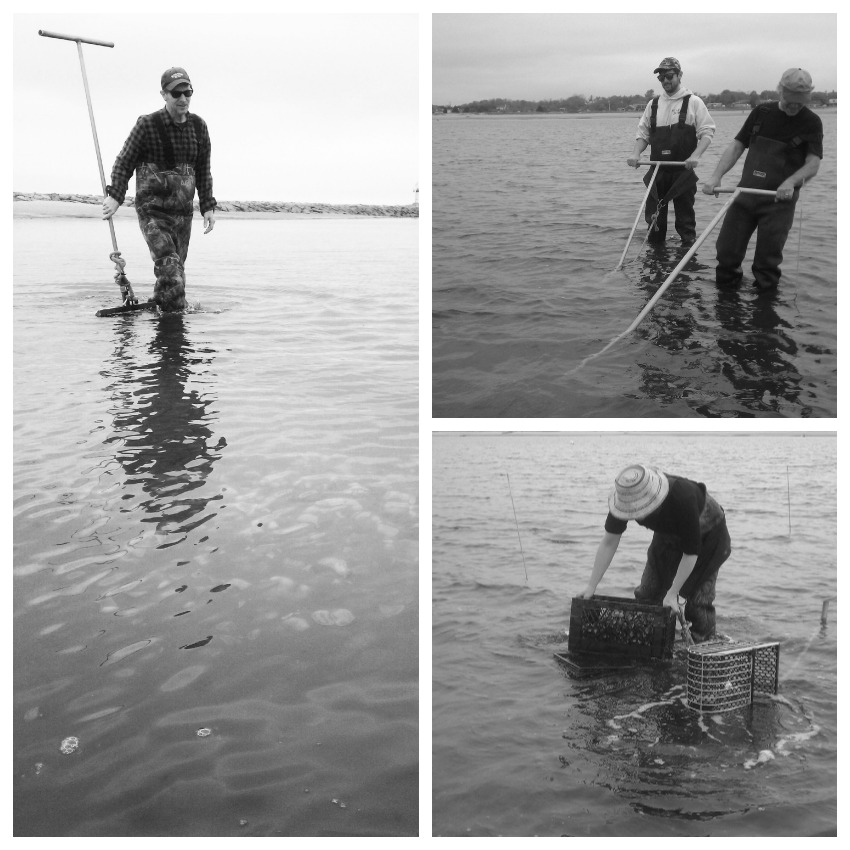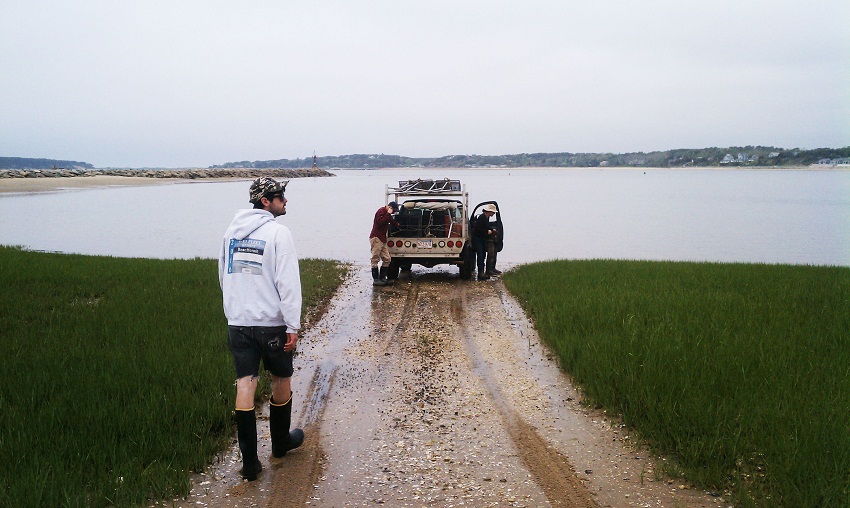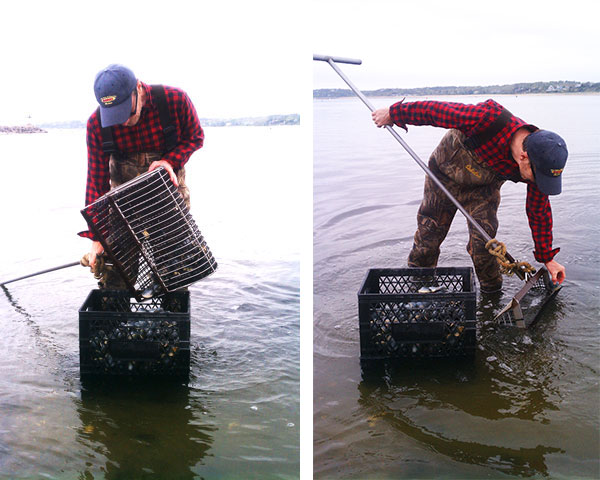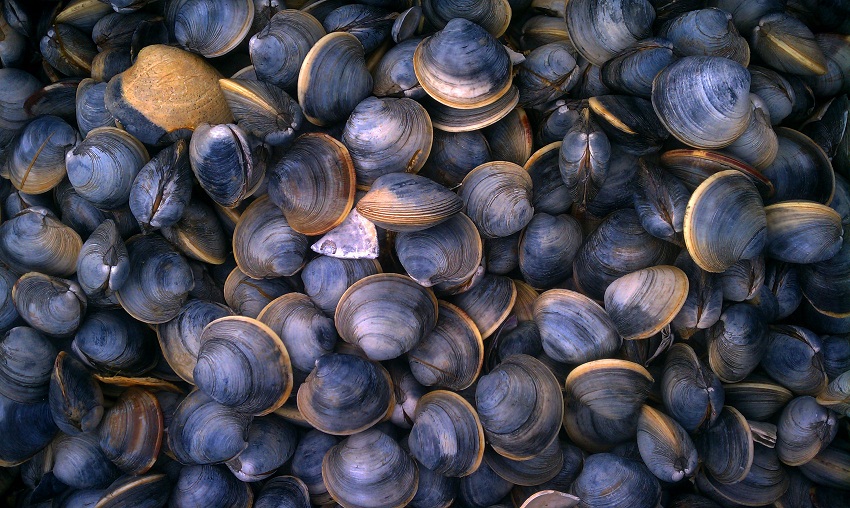The Woodburys: The Fam Behind the Clam
Welcome to Supply Chain, where we go behind the plate to get a feel for the day-to-day of Boston’s most relied-upon restaurant purveyors.
 Meet the Woodburys: Pat (left), Nick (top right, white sweatshirt), and Barbara (bottom right). Also here: Jim Rohrer (top right, dark t-shirt). All photos by Cassandra Landry for Boston magazine.
Meet the Woodburys: Pat (left), Nick (top right, white sweatshirt), and Barbara (bottom right). Also here: Jim Rohrer (top right, dark t-shirt). All photos by Cassandra Landry for Boston magazine.
Five minutes after I turn off of the main road in Wellfleet and hit a dead-end at the beach, I’m standing alone on a dune, my boots sinking a little in the sand. The long stretch of beach, winding around a lone jetty, is totally silent except for a few birds shooting the shit in easy chirps above me. Pat and Barbara Woodbury roll up in a weathered pick-up truck, all smiles. One of their two sons, Nick—home for the summer from New York City—is close behind.
They park on the beach where the tide is already halfway out, the high ground is awash with a carpet of shell fragments and neon green shoots of grass. Apparently, a ten-foot tidal exchange washes over where we’re standing twice a day, leaving rivulets of water rushing down the slope under our feet. In a matter of minutes, they’ve all shimmied into pairs of waders and hauled down crates and bull rakes (imagine a heavy rake with a basket and 20 pointy teeth on the end) from the bed of the truck.
“This is the best time of year, it really is. I’d say it’s before the bugs come out, but…” Pat says, grinning as a monster mosquito alights on the bill of his hat. “Low-tide changes an hour a day, and we come out two hours before low-tide, since the rakes need the water to really work well. Sometimes that means five in the morning, but that’s something we’re used to now.”
Woodbury clams are a mainstay on many of the city’s best menus, prized both for their sweet, buttery taste and the family that tends to them. It’s a life that the two marine-biologists never quite planned on, but over the past 27 years, Pat and Barbara have become invaluable to chefs all over the city. It has meant living on a lunar calendar day-to-day and battling the elements throughout the seasons, but Pat says they don’t miss being trapped into a traditional schedule.
“People who get into this business usually don’t like confining to a certain kind of structure,” he says, looking out onto the water where Barbara and Nick are jiggling their rakes into the sand and chatting. “There’s a freedom to it that is very appealing for some folks.”
Jim Rohrer, a familiar face to those who receive deliveries from him every week in the city, shows up with an extra pair of waders for me, and dives right in to harvest. When he moved to town seven years ago, his wife noticed a sign at the library advertising a position with a shellfish company. He called the number and got Barbara, who hired him on the spot. She must have known they’d all get along—“The rest is history!” she calls out—because the chemistry between all of them is instantly palpable.
“This was the hot spot for aquaculture when we got here. It was one of the early places that people were taking seed that were grown in a hatchery and then growing them out here,” Pat says, when the group starts reminiscing about the company’s early days. “All they’re really doing is living just like they would in the wild. We just tend to them and keep predators away, and that’s really all we do.”
I find it hard to believe it’s as easy as all that, even when Pat sticks his hand about two inches into the sand to show me where the clams reside. An ink-black cloud of sand and sediment seeps out from around his hand.
“I guess there was a bit of a learning curve in the beginning, but I don’t think there’s really any theory to it,” he continues, laughing and pulling his hand back out of the water. “You just dig. The downside is it takes these things three years to grow to legal size, so if you make a mistake, you have to live with it for a long time.”
For their customers, who number in the fifties and are all ardently devoted to their shellfish, it’s about more than the stellar quality of the little, middle, and top neck clams they offer.
“I love the personal connection you feel with him when you’re using his product,” says Michael Scelfo, chef of the upcoming Alden & Harlow. “He’s out there weathering the storms, harvesting and delivering his amazing buttery clams in a really human way. I can’t think of a better example of the type of food I want to showcase.”
Each year in the late spring or early summer months, the Woodburys receive buckets of 100,000 clam seeds from the hatchery, which then go into plastic mesh trays filled over with sand. Each tray holds about 3,000 clams and will spend the summer rollicking around until they grow to the size of a thumbnail, at which point they are taken out and re-planted in rows. It’s not always a predictable process.
“Most people think of fishermen as these rugged loners, but everybody really shares information around here,” he says. “You learn from other growers. There are times when you think you should have taken the net off earlier, or you get a really bad winter, with insane amounts of cold and ice and mortality rates that are out of your control. There’s never a dull moment.”
They all nod and the silence takes over for a few moments. After a minute, Rohrer heaves a satisfied sigh as he empties his rake. The clams, all dark periwinkle blue with black and yellow striations, are breathtaking when piled on top of each other in a heap.
“These are just beautiful, Pat,” he says. And he’s right.




